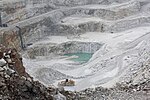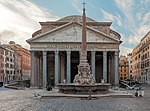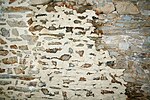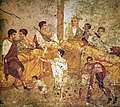Roman concrete, also called opus caementicium, was used in construction in ancient Rome. Like its modern equivalent, Roman concrete was based on a hydraulic-setting...
19 KB (2,032 words) - 09:36, 25 June 2024
whereas Roman concrete could depend only upon the strength of the concrete bonding to resist tension. The long-term durability of Roman concrete structures...
120 KB (13,835 words) - 06:47, 19 September 2024
surviving buildings were constructed. It used new materials, particularly Roman concrete, and newer technologies such as the arch and the dome to make buildings...
101 KB (12,330 words) - 17:14, 16 September 2024
Concrete Roman is a slab serif typeface designed by Donald Knuth using his METAFONT program. It was intended to accompany the Euler mathematical font which...
1 KB (104 words) - 17:48, 6 February 2024
Lime (material) (section Roman concrete)
The Romans used two types of lime mortar to make Roman concrete, which allowed them to revolutionize architecture, sometimes called the Concrete revolution...
19 KB (2,351 words) - 16:22, 31 May 2024
making regular Roman concrete, brick dust can also be used. Besides regular Roman concrete, the Romans also invented hydraulic concrete, which they made...
47 KB (5,832 words) - 09:06, 5 September 2024
strength of concrete was improved by the reinforcing. Before the 1870s, the use of concrete construction, though dating back to the Roman Empire, and...
62 KB (7,223 words) - 20:50, 13 September 2024
The Roman architectural revolution, also known as the concrete revolution, is the name sometimes given to the widespread use in Roman architecture of...
12 KB (1,242 words) - 23:36, 4 March 2024
Dam (redirect from Concrete-face rock-fill dam)
structures still in use. Roman engineers built dams with advanced techniques and materials, such as hydraulic mortar and Roman concrete, which allowed for larger...
92 KB (11,138 words) - 03:04, 12 September 2024
Tobermorite (section Use in Roman concrete)
ingredient responsible for the longevity of ancient undersea Roman concrete. The volcanic ash that Romans used for construction of sea walls contained phillipsite...
11 KB (939 words) - 16:46, 31 May 2024
Self-healing concrete is characterized as the capability of concrete to fix its cracks on its own autogenously or autonomously. It not only seals the...
34 KB (3,990 words) - 16:58, 22 August 2024
Ancient Rome (redirect from Ancient Roman)
the end of the Republic. In the 1st century BC, Romans started to use Roman concrete widely. Concrete was invented in the late 3rd century BC. It was...
189 KB (21,525 words) - 01:53, 11 September 2024
Pantheon, Rome (redirect from Roman Pantheon)
results are available on the concrete used in the Pantheon; however, Cowan discussed tests on ancient concrete from Roman ruins in Libya, which gave a...
64 KB (7,568 words) - 19:42, 7 September 2024
erroneous conclusion. It has been determined that the durability of ancient Roman concrete is attributed in part to the use of quicklime as an ingredient. Combined...
23 KB (2,231 words) - 10:20, 8 August 2024
Romans incorporated concrete cores into a number of their masonry bridges and aqueducts, along with constructing spanning water conduits of concrete....
6 KB (540 words) - 11:00, 16 August 2024
materials, which Romans experimented with in the creation of building materials, particularly cements and mortars. Along with concrete, the Romans used stone...
68 KB (7,196 words) - 05:17, 24 August 2024
using lime mortar. Despite its enduring utility over many centuries (Roman concrete), lime mortar's effectiveness as a building material has not been well...
30 KB (4,286 words) - 05:02, 18 September 2024
architecture Ancient Roman engineering Ancient Roman technology Roman concrete Bannon, Cynthia. Gardens and Neighbors: Private Water Rights in Roman Italy. University...
68 KB (9,498 words) - 07:15, 6 September 2024
The most used material on this planet, concrete has been utilized since Egyptian and Roman times to create buildings like the Pantheon. Because of its...
3 KB (402 words) - 23:59, 20 March 2024
Dragged Across Concrete is a 2018 American crime thriller film written and directed by S. Craig Zahler. It stars an ensemble cast that includes Mel Gibson...
41 KB (3,687 words) - 04:13, 1 September 2024
domes was greatly facilitated by the invention of concrete, a process which has been termed the Roman Architectural Revolution. Their enormous dimensions...
28 KB (580 words) - 19:08, 28 February 2024
Pozzolana (category Concrete)
Greeks, it was the Romans who eventually fully developed the potential of lime-pozzolan pastes as binder phase in Roman concrete used for buildings and...
9 KB (1,103 words) - 16:15, 15 August 2024
Concrete Utopia (Korean: 콘크리트 유토피아) is a 2023 South Korean disaster-thriller film directed by Um Tae-hwa, who wrote the screenplay with Lee Shin-ji, based...
39 KB (3,494 words) - 17:54, 31 August 2024
Culture of ancient Rome (redirect from Roman culture)
developed and refined. The Roman concrete has remained a riddle, and even after more than two thousand years some ancient Roman structures still stand magnificently...
58 KB (7,593 words) - 21:05, 15 August 2024
Opus quadratum (category Ancient Roman construction techniques)
centered over the blocks in the row below. With the introduction of Roman concrete, continuous outer walls were often constructed, with some blocks laid...
3 KB (414 words) - 10:20, 8 April 2024
Roman theatres derive from and are part of the overall evolution of earlier Greek theatres. Much of the architectural influence on the Romans came from...
6 KB (692 words) - 14:59, 4 June 2024
Concrete degradation may have many different causes. Concrete is mostly damaged by the corrosion of reinforcement bars due to the carbonatation of hardened...
62 KB (7,758 words) - 20:00, 15 August 2024
Eifel Aqueduct (category Roman aqueducts outside Rome)
that, at the lowest level, the Roman engineers had placed a loose layer of stones. On this base, they set a concrete or stone U-shaped groove for the...
22 KB (3,093 words) - 11:26, 28 February 2024
impermeability of Roman dams was increased by the introduction of waterproof hydraulic mortar and especially Roman concrete in the Roman architectural revolution...
25 KB (1,050 words) - 07:49, 13 January 2024
practice of stamping concrete for various purposes began with the ancient Romans. In the nineteenth and twentieth centuries, concrete was sometimes stamped...
10 KB (1,275 words) - 13:36, 14 January 2024
























